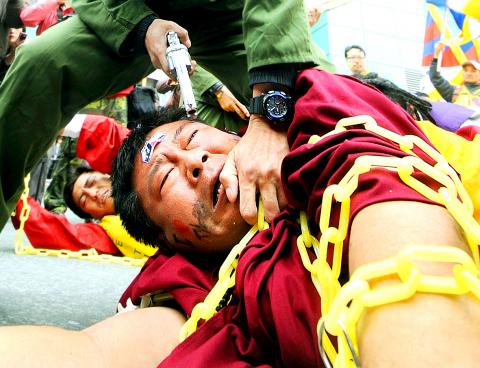Nearly 200 Tibetans and Taiwanese yesterday took to the streets in Taipei to voice their support for the independence and freedom of Tibet, while remembering those Tibetans who sacrificed their lives in an uprising against Chinese occupation of their country in 1959.
“Tibetans want to go home! The Dalai Lama wants to go home!” the crowd shouted as they marched. “Tibet belongs to Tibetans! Chinese Communist Party [CCP] get out of Tibet!”
Before the parade began, Tibetans performed a skit to show China’s repression of Tibetans.

Photo: Fang Pin-chao, Taipei Times
As the crowd rallied near Zhongxiao Fuxing MRT Station, three Tibetans dressed in traditional outfits ran out of the crowd, shouting “Free Tibet” and “Independence for Tibet.”
Soon, four others dressed in Chinese military uniforms ran after them, took them down, covered their mouths, tied them up with chains and pointed pistols at their heads.
“The ‘skit’ that the Tibetans just performed is not really a ‘skit,’ because it’s something that has happened a lot during the past decades to Tibetans living within Tibet under Chinese occupation,” said Son Yu-lian (孫友聯), secretary-general of the Taiwan Labour Front, which was one of several civic groups taking part in the Free Tibet parade.
Speaking to the demonstrators, Taiwan Friends of Tibet (TFOT) president Chow Mei-li (周美里) said that Tibetan spiritual leader the Dalai Lama’s announcement earlier in the week that he would retire from exile government functions was a “slap at the CCP regime.”
“Traditionally, the Dalai Lama serves as both the spiritual and political leader of Tibet, and never retires,” Chow said. “But now, even the Dalai Lama has announced his retirement — we want to ask when is the CCP government going to retire?”
She added that the current Dalai Lama had pushed for democratic reforms in exile, leading to the elections of a legislative body and the government-in-exile through popular votes by Tibetans living in exile. In addition to the mostly adult demonstrators, there was also a high school student, Own Ching-ning (翁慶寧), who came from Taoyuan to join the parade.
“It’s just natural for us Taiwanese to join the Tibetans in their struggle for freedom, because we’re all facing the same threat — China,” Own said. “Although many people may think it’s the business of the grown-ups to support the free Tibet movement, I think people in high school are old enough to show care for the world.”
Jesse Duffield, a New Zealander who has been living in Taiwan for four years, said he has participated in many events related to the Tibetan cause, “because of my support for the Tibetans’ right to determine their own future as an independent nation.”
Besides showing their support for Tibet’s freedom, the demonstrators also observed a minute of silence and prayed for people in Japan who are suffering from the devastation brought by a massive earthquake and tsunami on Friday.

Beijing could eventually see a full amphibious invasion of Taiwan as the only "prudent" way to bring about unification, the US Department of Defense said in a newly released annual report to Congress. The Pentagon's "Annual Report to Congress: Military and Security Developments Involving the People's Republic of China 2025," was in many ways similar to last year’s report but reorganized the analysis of the options China has to take over Taiwan. Generally, according to the report, Chinese leaders view the People's Liberation Army's (PLA) capabilities for a Taiwan campaign as improving, but they remain uncertain about its readiness to successfully seize

Taiwan is getting a day off on Christmas for the first time in 25 years. The change comes after opposition parties passed a law earlier this year to add or restore five public holidays, including Constitution Day, which falls on today, Dec. 25. The day marks the 1947 adoption of the constitution of the Republic of China, as the government in Taipei is formally known. Back then the Chinese Nationalist Party (KMT) governed China from Nanjing. When the KMT, now an opposition party in Taiwan, passed the legislation on holidays, it said that they would help “commemorate the history of national development.” That

Taiwan has overtaken South Korea this year in per capita income for the first time in 23 years, IMF data showed. Per capita income is a nation’s GDP divided by the total population, used to compare average wealth levels across countries. Taiwan also beat Japan this year on per capita income, after surpassing it for the first time last year, US magazine Newsweek reported yesterday. Across Asia, Taiwan ranked fourth for per capita income at US$37,827 this year due to sustained economic growth, the report said. In the top three spots were Singapore, Macau and Hong Kong, it said. South

Snow fell on Yushan (Jade Mountain, 玉山) yesterday morning as a continental cold air mass sent temperatures below freezing on Taiwan’s tallest peak, the Central Weather Administration (CWA) said. Snowflakes were seen on Yushan’s north peak from 6:28am to 6:38am, but they did not fully cover the ground and no accumulation was recorded, the CWA said. As of 7:42am, the lowest temperature recorded across Taiwan was minus-5.5°C at Yushan’s Fengkou observatory and minus-4.7°C at the Yushan observatory, CWA data showed. On Hehuanshan (合歡山) in Nantou County, a low of 1.3°C was recorded at 6:39pm, when ice pellets fell at Songsyue Lodge (松雪樓), a